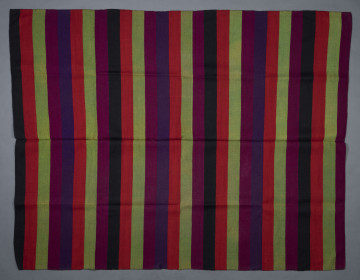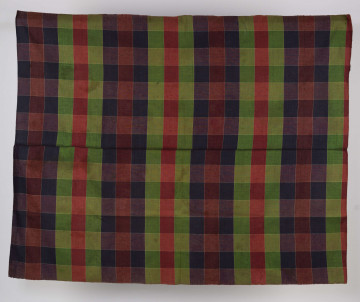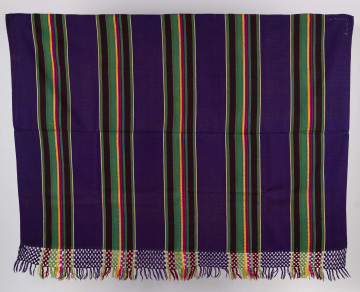
Striped rug
1920
National Museum in Lublin
Part of the collection: Folk craft of the Lublin Region (19th/20th c.)
This linen-wool fabric, called ‘kraciak’, was woven on narrow looms by Józefa Smyk from the village of Sienciaszka in the Łuków municipality in about 1900. It is stitched lengthwise from two parts. It was made with a row weave in a narrow weaving workshop. The warp is black and three celadon threads are introduced every 7.5 cm to emphasise the check pattern. The weft is in red (poppy) and black colours and the stripes are 7.5 cm wide. This fabric was used as a bedspread (the one shown here was used for this purpose) or as bedding or clothing material. In terms of colour, bedspreads were the best, as they were woven from threads of four or five colours. Bedding made from tailoring was usually made in two or three colours with a grid size of about 5 cm. Tailoring was being woven in the northern part of the Lublin region at the end of the 19th century. They were used for skirts, called plaids, aprons, blouses and jackets. This type of material was mainly used by young women, who introduced clothes modelled on urban fashion into their wardrobes. It was usually two-coloured (usually black and white) and had a small check pattern. In the inter-war period the set of colours, their quantity, selection and size depended on fashion and individual tastes. The common distinguishing feature of Lublin tailoring was dark, subdued colours with a noble set. Fabrics with an aggressive set of colours were not woven.
Author / creator
Dimensions
cały obiekt: height: 180 cm, width: 128 cm
Object type
trellis
Technique
weaving: rows
Material
flax, wool
Creation time / dating
Creation / finding place
Owner
The National Museum in Lublin
Identification number
Location / status

1920
National Museum in Lublin

1905 — 1925
National Museum in Lublin

1925
National Museum in Lublin
DISCOVER this TOPIC
Museum of King Jan III's Palace at Wilanów
DISCOVER this PATH
Educational path